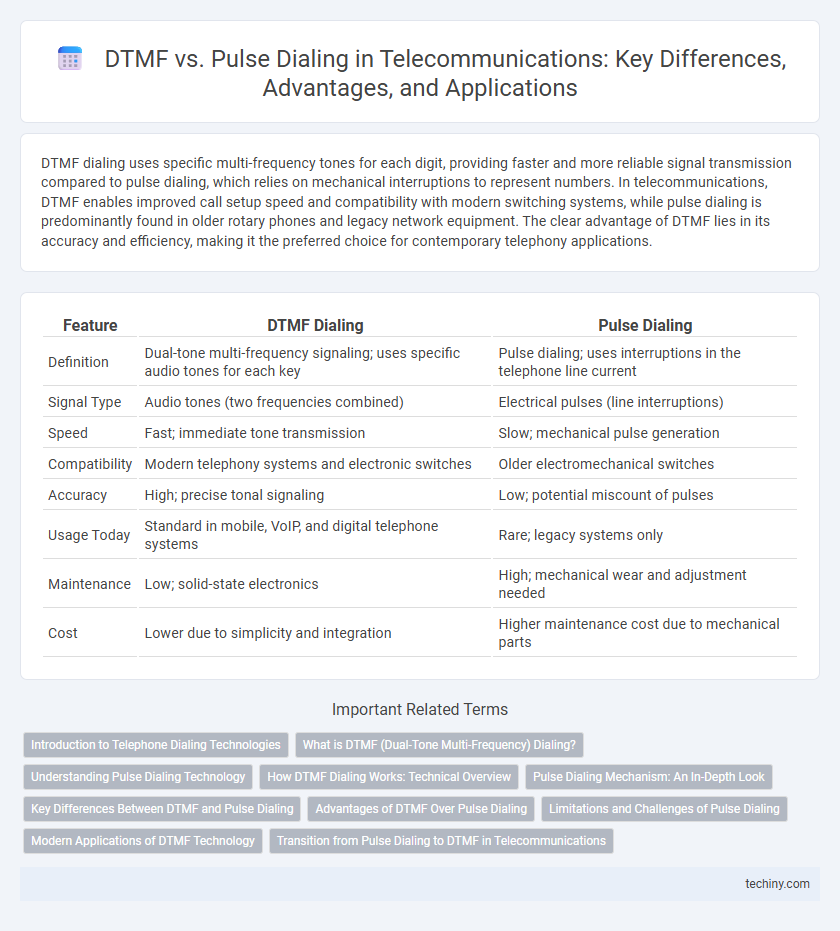DTMF dialing uses specific multi-frequency tones for each digit, providing faster and more reliable signal transmission compared to pulse dialing, which relies on mechanical interruptions to represent numbers. In telecommunications, DTMF enables improved call setup speed and compatibility with modern switching systems, while pulse dialing is predominantly found in older rotary phones and legacy network equipment. The clear advantage of DTMF lies in its accuracy and efficiency, making it the preferred choice for contemporary telephony applications.
Table of Comparison
| Feature | DTMF Dialing | Pulse Dialing |
|---|---|---|
| Definition | Dual-tone multi-frequency signaling; uses specific audio tones for each key | Pulse dialing; uses interruptions in the telephone line current |
| Signal Type | Audio tones (two frequencies combined) | Electrical pulses (line interruptions) |
| Speed | Fast; immediate tone transmission | Slow; mechanical pulse generation |
| Compatibility | Modern telephony systems and electronic switches | Older electromechanical switches |
| Accuracy | High; precise tonal signaling | Low; potential miscount of pulses |
| Usage Today | Standard in mobile, VoIP, and digital telephone systems | Rare; legacy systems only |
| Maintenance | Low; solid-state electronics | High; mechanical wear and adjustment needed |
| Cost | Lower due to simplicity and integration | Higher maintenance cost due to mechanical parts |
Introduction to Telephone Dialing Technologies
Dual-Tone Multi-Frequency (DTMF) dialing generates specific audio tones for each key press, enabling faster and more reliable signal transmission compared to pulse dialing, which sends a series of electrical pulses corresponding to each digit. DTMF technology enhances call setup efficiency and supports interactive voice response systems, making it the preferred method in modern telephony. Pulse dialing, once standard in rotary phones, is now largely obsolete due to slower speed and limited compatibility with digital exchanges.
What is DTMF (Dual-Tone Multi-Frequency) Dialing?
DTMF (Dual-Tone Multi-Frequency) dialing uses a combination of two specific audio frequencies to represent each key pressed on a telephone keypad, allowing faster and more reliable signal transmission compared to pulse dialing. Each key generates a unique pair of tones corresponding to its row and column frequencies, enabling quick recognition by telephone switching systems. This technology revolutionized telecommunication by enabling automated menu navigation and enhanced compatibility with digital systems.
Understanding Pulse Dialing Technology
Pulse dialing technology transmits digits by rapidly interrupting the telephone line current, creating a series of electrical pulses that represent each number dialed. This method, used predominantly in rotary phones, contrasts with DTMF, where dual-tone signals generate distinct audio frequencies for each key press. Despite being slower and less reliable in noisy environments, pulse dialing remains important for understanding legacy telecommunication systems and infrastructure compatibility.
How DTMF Dialing Works: Technical Overview
DTMF dialing operates by transmitting specific dual-tone frequencies for each button pressed, combining two distinct signals from a low-frequency and a high-frequency group to represent digits. The telephone system decodes these tones instantly, enabling faster call setup compared to pulse dialing, which involves interruption of the telephone circuit in a timed sequence. This frequency-based signaling enhances compatibility with modern digital switching equipment and supports advanced telephony services such as interactive voice response (IVR) systems.
Pulse Dialing Mechanism: An In-Depth Look
Pulse dialing operates by rapidly interrupting the telephone line current to signal a digit, typically generating a series of pulses that correspond to each number dialed. This mechanism relies on the rotary dial's mechanical contacts to momentarily break the circuit, with standard pulse rates around 10 pulses per second and pause durations critical for accurate signal interpretation. Despite being largely replaced by Dual-Tone Multi-Frequency (DTMF) signaling due to its slower speed and susceptibility to line noise, pulse dialing remains a foundational technology in legacy telephony systems.
Key Differences Between DTMF and Pulse Dialing
DTMF (Dual-Tone Multi-Frequency) dialing uses specific audio tones to represent each digit, enabling faster and more reliable signal transmission compared to Pulse dialing, which relies on interrupting the telephone circuit to count pulses for each number. DTMF supports advanced telecommunication features such as interactive voice response (IVR) and auto-dialing, while Pulse dialing is limited to basic number transmission and is prone to errors in noisy line conditions. Most modern telecommunication systems and devices favor DTMF for its compatibility with digital networks and enhanced signaling capabilities.
Advantages of DTMF Over Pulse Dialing
DTMF (Dual-tone multi-frequency) systems offer faster call setup times compared to pulse dialing due to their ability to transmit signals simultaneously rather than sequentially. DTMF provides improved reliability and noise resistance, ensuring clearer and more accurate signal detection in telecommunications networks. Enhanced compatibility with modern digital switching systems makes DTMF the preferred choice for advanced telephony services over traditional pulse dialing.
Limitations and Challenges of Pulse Dialing
Pulse dialing faces significant limitations including slower signal transmission compared to DTMF, which reduces efficiency in modern telecommunication networks. The mechanical nature of pulse dialing makes it susceptible to wear and signal distortion, causing frequent dialing errors and connection issues. Compatibility challenges arise as contemporary digital systems predominantly support DTMF, rendering pulse dialing largely obsolete in advanced telephony infrastructure.
Modern Applications of DTMF Technology
DTMF technology is widely used in modern telecommunications for interactive voice response (IVR) systems, enabling users to navigate menus efficiently by pressing keypad tones. Unlike pulse dialing, which relies on mechanical interruptions, DTMF signals transmit distinct audio frequencies that are quickly and accurately recognized by digital systems. This facilitates applications such as secure banking by phone, teleconferencing, and remote control operations in IoT devices.
Transition from Pulse Dialing to DTMF in Telecommunications
The transition from pulse dialing to Dual-Tone Multi-Frequency (DTMF) signaling marked a significant advancement in telecommunications technology, enhancing call setup speed and dialing accuracy. DTMF's use of distinct audio tones for each key press enabled more reliable and faster signal processing compared to the mechanical interruption method of pulse dialing. This shift also facilitated the development of automated telephone systems and advanced switching technologies, supporting the evolution of modern digital communication networks.
DTMF vs Pulse dialing Infographic

 techiny.com
techiny.com